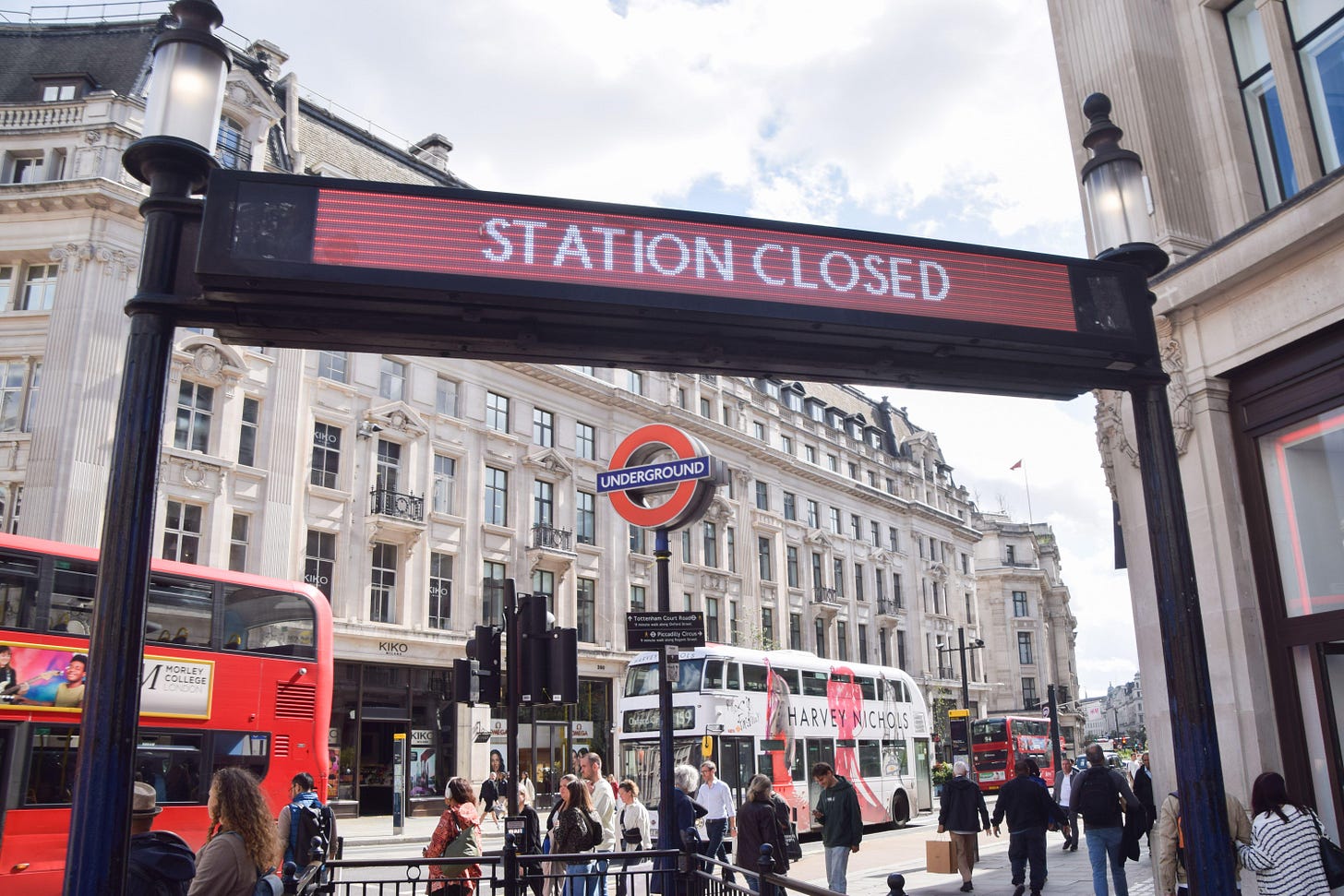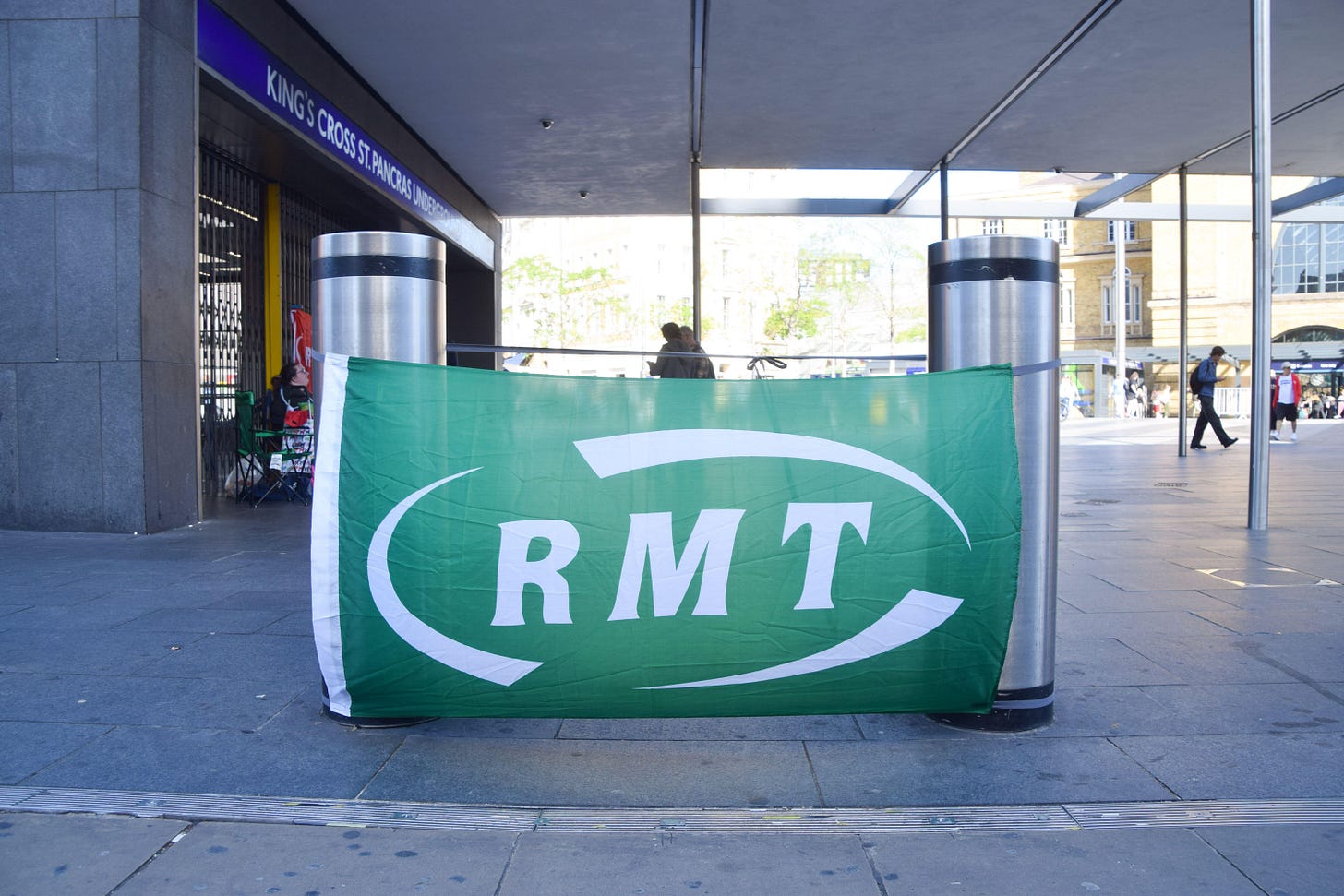London's tube drivers are divided
Plus: A £20m home in Mayfair, the growth of "water charges" in London restaurants, and another closure for London's troubled high street cinema chain.
After strike action brought the London Underground to a halt for a week in September, last week’s announcement that the RMT union had reached a pay deal was met with headlines about a deal that ruled out strikes for the next three years.
A lot of coverage of tube strikes is overly simplistic and partisan. This week we’ve been talking to the key players to ensure you understand the nuanced tensions behind the scenes between rival unions — and explain it means for your commute.
Scroll to the end to find out why not all tube drivers are in agreement.
We’ve got a fascinating members-only London Centric story coming this weekend — if you want to support ambitious, original investigative journalism about the capital that’s entirely funded by readers, make sure you’re subscribed.
The rise of the water charge in London restaurants
London Centric’s story on how some of the capital’s restaurants have started switching the ‘service charge’ to an ‘admin charge’ to sidestep tipping legislation was picked up by The Times, Time Out, and even some other outlets without the ‘Time’ in their name.
One reader got in touch off the back of it to let us know they’d spotted an uptick in online complaints from customers being charged for water at London restaurants.
Licensing regulations require restaurants that sell alcohol to offer tap water for free. But it seems that customers asking for still water and not paying attention are being served up bottles that have been “filtered” at a charge.
If customers are happy to pay for a flask of filtered water, that’s fair enough. And ultimately there’s a tension between customers’ unwillingness to put up with higher menu prices and the need for restaurant owners to make a profit.
There’s no suggestion that these restaurants are doing anything underhand. But among those charging, we found:
At Fallow in St James’s Market, filtered still and sparkling water is at £2 per person.
Pasta bar Notto, with spots in Covent Garden and Piccadilly, charges £1.50 per person for “unlimited” still or sparkling filtered water.
Canteen in Notting Hill has a £2 water charge, which they explained in a response to a critical Google review is an “in-house system that filters and carbonates water for our guests, which of course is at a cost to us”.
Brother Marcus in Covent Garden charges £1 for filtered or still water.
Urban Leisure Group, behind the Coin Laundry in Exmouth Market and pizza restaurant Never For Ever in Kentish Town, charges £1.50 per head for still or sparkling water at seven of its London bars and restaurants.
Megan’s, which operates twenty restaurants across London, and charges £1.50 per person for filtered still water or sparkling, and donates 20% of those water sales to “local charities & causes.”
Have you noticed any other new or unusual charges on your restaurant bills? Let us know.
All of our best stories come from our community of readers — please do get in touch if you’ve got a tip we should be looking into via WhatsApp or email.
The company that can’t stop closing London cinemas closes another cinema.
Really Local Group’s Throwley Yard cinema closed this weekend, weeks after we profiled the company that can’t stop opening disastrous cinemas on London’s high streets.
The south London cinema received millions of pounds of high street regeneration cash from both the local council and central government but it just doesn’t seem to have been able to get people through the door. Bailiffs started turning up and Disney withheld its big movies over unpaid debts. There’s no winner here, with a potentially great venue closed, staff out of work and millions of pounds of public money down the drain.
One curious element is that Really Local Group founder Preston Benson, in response to reporting by London Centric and others, recently decided to pay a new PR agency to help place comment pieces in media outlets about how he had been frustrated by local councils in his bid to regenerate high streets. We hope the newly-unemployed staff in Sutton aren’t left out of pocket.
Preposterous property of the week
Do you want to live in a six bedroom Mayfair townhouse sandwiched between Hyde Park and Grosvenor Square? This new-build mansion complete with an underground swimming pool, cinema and gym might be just the property for you.
Culross House was once the servants’ quarters for the Earl of Essex but its current incarnation has been fitted out by an interior designer who never said no to an extra piece of marble — especially in the spa room.
But the most interesting part, as ever, comes when you move beyond the RightMove gawping and start digging through property ownership records which, as ever, reveal so much about modern London. Bought for £3.9m in 2012, it is owned by a company based in the tax haven of Luxembourg, which public records state is in turn controlled by Sir Keith Mills. He is a former director of Tottenham Hotspur who made a fortune by inventing the Air Miles and Nectar loyalty schemes.
The property was completely redeveloped by property developer Kam Babaee, who tried to market it by featuring it in a Channel 5 programme entitled ‘Sally Lindsay’s Posh Sleepover’. Babaee faced bankruptcy proceedings in 2024 where he was declared “hopelessly insolvent” by a high court judge, before later reaching an agreement with his creditors.
Originally listed for sale at £32.5m in 2018, Culross House’s asking price has since been slashed to £20m — and given the state of the luxury property market any London Centric readers thinking of making a bid might want to try going even lower.
The capital’s best quality comments section has been in action again after this weekend’s piece on the unbuilt motorways of the capital, as people discussed how London was going to change if the planned Ringways had been built. Do check out that piece if you missed it.
What the tube pay deal really means — and why there’s a split between the tube’s train driving unions
By Polly Smythe
Back in September the London Underground came to halt during strike action by the Rail, Maritime and Transport Workers (RMT) union that saw Londoners take to Lime bikes en masse. Last week RMT accepted a three-year pay deal, apparently bringing the threat of strike action to an end.
Heralded by both the RMT and Transport for London as a victory, it was widely reported that the capital was in for three years without industrial action on the tube. But the RMT have told London Centric that the latest deal “doesn’t mean there’s a ‘no strike’ arrangement”. Instead, they say the reality is “quite the opposite”. So what’s going on, and how likely is more disruption?
What is the deal?
TfL’s initial offer to transport workers, which includes station and maintenance staff, was a one-year pay increase of 3.4%. Following strike action, the pay offer was extended into a multi-year deal, with a guaranteed minimum increase of 3% from April 2026 and 2.5% from 2027. A payment of £400 for working on Boxing Day, initially only on offer to some workers, will also be extended to all staff.
John Leach, assistant general secretary of the RMT, told London Centric that September’s strike action “shifted the employer” into agreeing a deal.
Last week the proposed deal was put to RMT representatives: “They’d been asked to go away and speak to the people they represent, then come back. They did, and they said that most people felt that the deal was reasonable. And that’s why we’ve accepted it.”
But crucially, the union’s central demand for a 32-hour four-day working week to combat fatigue — used as the main justification for the strike in September — was rejected by TfL bosses.
“We’ll be back for that.”
Leach, the RMT representative, told London Centric that reports suggesting all future strike action is off the table aren’t quite right: “What it means is that we’ve settled the issue of the annual pay rise for three years, but that’s all we’ve settled. In actual fact, you could argue that now allows us to focus on other things more diligently.”
This includes potential action to push Transport for London to accept a 32-hour working week.
“That’s still an aspiration,” said Leach. “We’ll be back for that.”
The union split
To understand what’s going on, you need to understand the nuanced unionised politics of London Underground staff.
Mention the words “tube” and “strike” to many London commuters, and they might start spouting off about the RMT union, which has a reputation as the most radical and receives the most media coverage.
While the RMT is by far the biggest union among London Underground staff with around 12,000 members, some employees are represented by other organisations:
Train drivers’ union Aslef, which competes with the RMT to represent tube drivers
The Transport Salaried Staff Association, which represents managerial and technical staff, including clerical workers
Unite, which represents some engineering staff
This mix of different union memberships can create tensions, especially among drivers.
When a vacancy for a tube driver role comes up, TfL doesn’t advertise externally, instead hiring internally from its existing non-driving staff. Those staff are likely to be RMT members, as the union is by far the biggest for London Underground workers who aren’t drivers. Until they get in a cab, they can’t be Aslef members, as the union only represents drivers. But once staff do become drivers, they can choose to remain in the RMT or to join Aslef, as both unions are recognised by TfL.
“Exactly the sort of deal every trade union should be trying to achieve”
If drivers are unhappy with the way one union is negotiating their pay and conditions, they can quit and join the other union. This essentially creates a competition between the two unions to win over the most tube drivers — and a subtly different approach.
Back in April, TfL presented a set of proposals for a 35-hour four-day week for London’s tube drivers to both the RMT and Aslef.
Aslef members voted in favour of the proposals, with the union calling it a “once in a generation opportunity to achieve the improvement in quality of life that we have campaigned for over decades.”
Finn Brennan, an Aslef organiser on the London Underground, told London Centric that the proposal by a management was a “major achievement” and “exactly the sort of deal every trade union should be trying to achieve.”
“That is not acceptable to us”
But RMT members rejected the same offer, with the union saying the proposal for a four day week didn’t also cut the total number of hours in the working week.
Under TfL’s proposal, shifts on the four working days would be lengthened, which Leach described as five day’s work “crammed into four.”
“It would mean that you’re driving the train for longer on your shift,” he said. “That is not acceptable to us because it’s a very tough job.”
A source familiar with the issue, said: “The offer was rejected by RMT and when drivers are taken as a whole across both unions in their respective referendums, more drivers have expressed a rejection of the offer than have accepted it.”
Drivers working overtime
There are around 3,500 tube drivers on the London Underground, with Aslef representing slightly more than the RMT. Without the RMT’s approval, TfL has been unable to implement its four-day week plan.
Stuck at an impasse, TfL is now implementing the Aslef-backed 35-hour four-day working week on an optional basis, meaning drivers can choose if they want to work their shifts across four days or five. But the prospect of drivers operating side by side within the depot on two different sets of terms and conditions risks being a logistical nightmare for scheduling.
A TfL spokesperson said it could make the changes at no extra cost: “We have set out to our trade unions how a four-day working week would work for our train drivers. Following extensive engagement on the proposal, we are making the new working pattern available for train drivers on a voluntary basis. No changes will be enforced, and those who wish to remain on their current five-day working week pattern will be able to do so.”
At the moment, full-time drivers aren’t allowed to work overtime, because of the gap required between shifts for safety reasons. But that would change under Aslef-backed plan for a compacted four-day working week. While overtime pay is an attractive financial prospect for some drivers, there’s also concern it will contribute further to fatigue.
For the RMT, there’s concern that what starts out as a voluntary change could in practice feel, or actually become mandatory change. If that happens, then commuters might face further strike action and find themselves back on their Lime bikes.










I don’t mind paying for filtered water. The restaurant is bearing a cost for both the filtering equipment and their water bill. It is, of course, also a way to extract some cash from customers in lieu of putting up the price of dishes. Restaurants have very very tight margins, I want them to survive and thrive
I like restaurants that donate the water money to charity